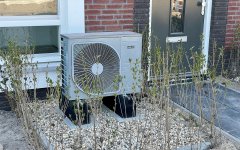Sustainable heating
Do you want to (eventually) switch from natural gas to a sustainable way of heating and hot water? Then insulating your home is the first step. So look first at saving energy by insulating.
A warm home with a (hybrid) heat pump
We are switching to renewable energy sources and slowly saying goodbye to natural gas. Natural gas-free living means no longer using natural gas to shower, cook or heat your home.
Most homes are now heated with a boiler that runs on natural gas. A sustainable alternative is a (hybrid) heat pump. This heats your home without natural gas. Or the heat pump cleverly works together with your central heating boiler, using much less natural gas. This is called a hybrid heat pump.

Is a (hybrid) heat pump for you?
In most cases, yes. Which type of heat pump is most suitable depends on your budget and desired living comfort. But the degree of insulation is also important. For new construction and houses that are well insulated, an electric heat pump is a smart choice. A hybrid heat pump can also benefit less well-insulated homes. The better insulated your home is, the greater the benefit. Insulating helps and can always be done in steps. An insulated home brings more comfort. It stays nice and warm in the winter and cooler in the summer.
Can't figure it out yourself?
The Sustainable Building Counter is the energy counter for Wassenaar. The municipality pays the Sustainable Building Counter and therefore the counter gives free and independent telephone advice. You can go there with all your questions about sustainable (re)construction, energy savings and energy generation. Want to know more? Go to the website of Duurzaam Bouwloket or call 070 - 208 30 37.
Nationwide grant for making your home more sustainable
You ask for money back after you have a (hybrid) heat pump or solar water heater cooktop installed. Or after you insulate your home. Different amounts are available for each measure. For more information about the national ISDE subsidy, visit the Rijksoverheid website.
Your situation: no mandatory removal of natural gas until 2030
The municipality drew up a transition vision for heat in 2021. This states how we in Wassenaar will switch from natural gas to sustainable heating sources. The main points of the transition vision for heat are:
- Until 2030, homes in Wassenaar will not be required to go off natural gas.
- We are now fully committed to reducing energy consumption. By insulating homes, low-temperature heating and using energy-efficient technical systems such as a hybrid heat pump.
- You can see what the possibilities are for your neighborhood on Sustainable Heat for Wassenaar. There will be an update in 2026 with the latest for technology and costs, for example. Look at the Map for details about your neighborhood.